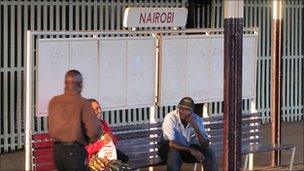New lease of life for Kenya's 'lunatic' railway
- Published

The passenger train crash in 1999 which killed 31 people was one of a series of disasters to hit the railway dubbed the lunatic line.
The African Development Bank has just approved a £24.8m (KES 3.59bn, $39.8m) loan to help finance the rehabilitation of the dilapidated Kenya-Uganda railway.
The project involves upgrading the existing line between Mombasa on the Indian Ocean to the shores of Lake Victoria - the route once dubbed the "lunatic line" because of the high cost of building it both in terms of money and human life.
The total cost of the upgrade in Kenya will cost between £1.8bn and £3bn ($3bn to $5bn).
Mugo Kibati of Kenya's Vision 2030, an ambitious development plan for Kenya that aims to see annual growth rates of 10% over the next 20 years, said the new railway would play a key role in bringing that about.
The government is hoping to attract private, commercial investors. Mr Kibati is optimistic it can be done - just as it was more than 100 years ago when the original line was built by Britain, which in its day transformed the region.
The aim then was to create a route linking Mombasa to Uganda, the source of the Nile and to open up the "interior" of Africa.
Escalating costs led to enormous opposition to the railway. The work was dangerous and difficult. At least 2,000 workers lost their lives, many of them Indian labourers imported to East Africa to build the railway.
Man-eating lions
Lt Col Patterson's contemporary account describes how malaria, dysentery and other deadly diseases, as well as accidents and wild animals all took their toll.
"Our work was soon interrupted in a rude and startling manner," he wrote.
"Two most voracious and insatiable man-eating lions appeared upon the scene and for over nine months waged an intermittent warfare against the railway and all those connected with it in the vicinity of Tsavo."
One of many victims was the unfortunate superintendent Charles Ryall, who was dragged from his carriage and killed by a lion.
The lunatic line is now but a pale shadow of its former self. The old station building built by the British still stands proud in central Nairobi. But just outside the concourse, matatu taxis tout for passengers, who have largely deserted the trains.
For years the railway has been neglected, mismanaged and starved of funding.
The Kenya Railways Corporation still owns the line, but the railway itself is privately managed by Rift Valley Railways, a consortium of Kenyan, Ugandan and Egyptian companies, with technical expertise provided by a Brazilian company that took over the concession in 2005.
Just keeping the existing line functioning is a daunting task. Track is expensive to repair and maintain, and the railway has huge debts.
There have also been numerous derailments and delays in recent years, which makes me slightly nervous about our 15-hour, overnight trip to Mombasa.
Time warp
Inside Nairobi station, it is like stepping into a time warp. The arrivals and departures board looks as though it hasn't been updated since I first did the journey 28 years ago.
Then trains used to run every night. Now there is only one passenger train, running three times a week in each direction.
As we pull slowly out of the station shortly after 7pm, the sun is setting behind the shacks that have sprung up all along the track.

In addition to long distance trains to Mombasa and Kisumu, Nairobi is also a hub for commuter services
The ticket collector tells me to close the windows and lock the doors before going to sleep. But the window doesn't shut properly, the fan doesn't work, and the lights keep going on and off.
In the restaurant car the porcelain plates have been replaced by plastic, the waiters seem tired, and the silver coffee pots are dull and battered.
Even crawling along at a top speed of 20-to-30km (12-to-18 miles) an hour, the carriage lurches and bounces so violently, eating dinner is like trying to eat and ride on a bucking horse at the same time.
Most of my fellow passengers seem to be tourists - nostalgic for the old Kenya - a time of adventure and romance, but plans for revitalising or rebuilding the railway are more concerned with trying to win back freight than passengers.
The road to the coast runs parallel with the railway for much of the route, and heavily laden trucks churn up the pot-holed tarmac, taking goods to Uganda, Rwanda, Burundi, Sudan, Congo and beyond.
Commuter network
There are plans to replace the old narrow-gauge line with a new standard gauge line over the next three to five years, with high speed trains cutting the journey time from Nairobi to Mombasa from the current 15 hours to a mere two or three.
A new commuter network in Nairobi to relieve traffic congestion is also under consideration and a new rail corridor to the north, linking a new port at Lamu in northern Kenya to Ethiopia and to Juba in oil-rich and newly independent South Sudan.
Whether the private sector will have the confidence to invest in Kenya - ranked by Transparency International as one of the most corrupt countries in the world - remains a big question.
Much of the impetus for these projects is coming from the Chinese who are already transforming and rebuilding Africa's road networks all over the continent. China is anxious about maintaining oil supplies from South Sudan.
The future of East Africa could be transformed by an efficient and modern railway system. The multi-million dollar question is whether such an ambitious project to replace the old "lunatic line" can be funded and delivered on time.
Episode one of the two part series The Lunatic Line will be on BBC Radio 4 at 11am on Monday 18 July and after on BBC iPlayer.